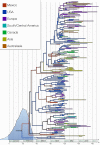The early molecular epidemiology of the swine-origin A/H1N1 human influenza pandemic
- PMID: 20025195
- PMCID: PMC2762654
- DOI: 10.1371/currents.rrn1003
The early molecular epidemiology of the swine-origin A/H1N1 human influenza pandemic
Abstract
Swine-origin pandemic human influenza A virus (H1N1pdm) has spread rapidly around the world since its initial documentation in April 2009. Here we have updated initial estimates of the rate of molecular evolution and estimates of the time of origin of this virus in the human population using the large number of viral sequences made available as part of the public health response to this global pandemic. Currently sampled H1N1pdm sequences share a most recent common ancestor in the first 7 weeks of 2009 with the implication that the virus was transmitting cryptically for up to 3 months prior to recognition. A phylogenetic reconstruction of the data shows that the virus has been circling the globe extensively with multiple introductions into most geographical areas.
References
-
- Novel Swine-Origin Influenza A (H1N1) Virus Investigation Team, Dawood FS, Jain S, Finelli L, Shaw MW, Lindstrom S, Garten RJ, Gubareva LV, Xu X, Bridges CB, Uyeki TM. Emergence of a novel swine-origin influenza A (H1N1) virus in humans. N Engl J Med. 2009 Jun 18;360(25):2605-15. Epub 2009 May 7. Erratum in: N Engl J Med. 2009 Jul 2;361(1):102. - PubMed
-
- Smith GJ, Vijaykrishna D, Bahl J, Lycett SJ, Worobey M, Pybus OG, Ma SK, Cheung CL, Raghwani J, Bhatt S, Peiris JS, Guan Y, Rambaut A. Origins and evolutionary genomics of the 2009 swine-origin H1N1 influenza A epidemic. Nature. 2009 Jun 25;459(7250):1122-5. - PubMed
-
- World Health Organization (2009) Pandemic (H1N1) 2009 - update 61. August 12th 2009.http://www.who.int/csr/don/2009_08_12/en/index.html
-
- Fraser C, Donnelly CA, Cauchemez S, Hanage WP, Van Kerkhove MD, Hollingsworth TD, Griffin J, Baggaley RF, Jenkins HE, Lyons EJ, Jombart T, Hinsley WR, Grassly NC, Balloux F, Ghani AC, Ferguson NM, Rambaut A, Pybus OG, Lopez-Gatell H, Alpuche-Aranda CM, Chapela IB, Zavala EP, Guevara DM, Checchi F, Garcia E, Hugonnet S, Roth C; WHO Rapid Pandemic Assessment Collaboration. Pandemic potential of a strain of influenza A (H1N1): early findings. Science. 2009 Jun 19;324(5934):1557-61. Epub 2009 May 11. - PMC - PubMed
-
- Drummond AJ, Rambaut A. BEAST: Bayesian evolutionary analysis by sampling trees. BMC Evol Biol. 2007 Nov 8;7:214.http://beast.bio.ed.ac.uk/ - PMC - PubMed
LinkOut - more resources
Full Text Sources
Other Literature Sources
Miscellaneous


